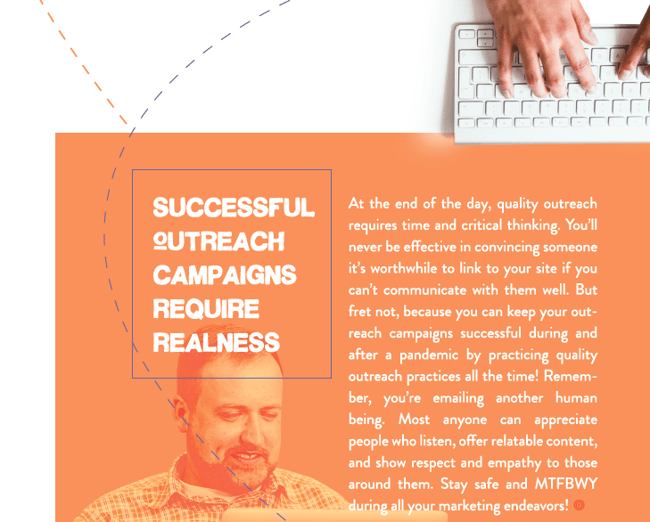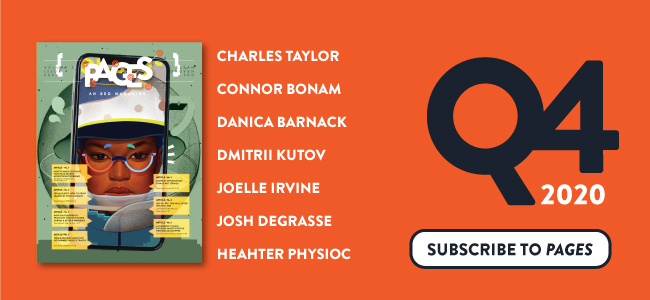
How should your outreach practices change during and after a pandemic?
They shouldn't.
Going into last year, who would have guessed what was to come. I don’t think I need to list out why 2020 was wild. People and businesses alike have felt their share of impact and have made huge strides to adapt to a new norm. If part of your SEO or online marketing strategy includes building worthwhile links — which requires good, manual outreach — you may find yourself asking, “What changes should I make to my outreach campaign?”
Well, I’m here to tell you that you shouldn’t have to make any changes…. if you’re doing it right.
Google wants people to have the best-informed search possible. Real links are an important part of that process. Real links come from people, and effective communication with people is how you secure quality links. No matter the type of links you’re looking to build, your outreach will play a major part in your success or failure to convert. Great email outreach is time consuming, thoughtful, and requires research, intentness, and perlustration. It sometimes feels like drudge work. And let’s not forget the social skills, influence, and salesmanship that can really push your outreach over the finish line.
2020 was hard enough. Don’t let your outreach campaigns be challenging as well. I’m going to cover the essential outreach basics that can help you remain successful during and after a pandemic.
Understand Your Business, Product, or Resource
First things first: This may seem obvious, but in my experience, if you can’t summarize in one sentence what your business, the product you’re selling, or the article/guide you are putting out there is about, your chances of having a successful email campaign will be pretty low. You must understand the unique value of what you are bringing to the table, since this will inherently help you persuade a person to add a link to your website. Remember, you are asking a person you don’t know to do you a favor, seemingly for nothing tangible in return.
Understand Your Online Audience
Similarly to understanding your website, you should also keep your target audience/buyer personas in mind. Fully comprehending the traits of these groups can help you identify and speak to what they value. Successful outreach campaigns naturally pair up a business or product with a webpage/website that has similar values. If the asset my client is pushing is about resources for women in business, my online audience should inherently already find value in that topic.
Organization
Obviously, you can’t send emails if you don’t have a list of websites/people to email. And organization is key. When you begin a campaign, you should know how you’re going to centralize everything pertaining to your link building project (websites, contact information, email, etc.). While you can use Google Docs and Sheets to do this, I recommend only using it for a small campaign; a high-output campaign will be difficult to manage and requires an outreach tool (such as Buzzstream or Pitchbox).
Link Prospecting
Once you know how you’re going to manage everything, you can begin finding and identifying relevant, authoritative websites. There are many ways to find target websites, but two of the most common methods are to comb through a competitor’s backlinks and find which ones are also relevant to you, or specify exactly what types of pages you are looking for using Boolean searches in Google.
Vetting websites for relevancy and authority are vital for ensuring you are building future-proof links to your website. A link you build today should be able to exist on that page and be relevant for the long term. It is important to spend the time, upfront, being thorough with your prospecting to make sure you are pursuing the best links. Given how time consuming outreach can be, you want to make sure you aren’t wasting precious hours reaching out to less-than-desirable or unlikely-to-convert websites.
At Page One Power, we evaluate a wide variety of link metrics to help assess the quality of a potential link. Some questions we ask when evaluating prospective targets:
- Does it make sense for my link to exist on this page?
- Does this website have positive metrics from key SEO tools such as Majestic SEO, Moz, SEMRush, or others?
- Does this page include links that are spammy or irrelevant?
- Has this website been updated recently?
Identify Targets and Contacts
As you find potential prospects, be sure to simultaneously document important information about those targets within your outreach list, because you’ll need that information later. Not notating it now only means you’ll have to waste precious time searching for that information again in the future, causing you to have to double up on your work. Information you should track includes contact name(s), their email(s), the company/website they represent, and any information pertaining to previous messages or contact that you’ve had with that website or individual.
During the craziness that was 2020, it was even more important to understand the situations of the people you are trying to contact. Have they changed business hours? Have they had to lay off employees? Are they receiving community help? Recognizing how they have been impacted — or are still being impacted — can help you decide how to approach them when you begin emailing.
Outreach Philosophy
One thing I try to impress upon my employees is the importance of sending outreach that they, themselves, would be alright receiving. Think about the spam emails you receive in your inbox. I get 10+ emails a day that include bad formatting, poor grammar, misspellings of my name, amongst other things that cause me to roll my eyes and immediately move on. Don’t make the same mistakes.
Another motto that can seriously inform your outreach and give you a good gut check: “If you wouldn’t say it in person, don’t send it in an email.”
At the end of the day, you should never send out an email that you also wouldn’t be alright opening, reading, and responding to. This is especially true in a world where people’s lives have been flipped upside down, stress levels are running high, and people are just trying to make it through their day healthily and happily.
Email Fundamentals
Each industry is different, but across the board there are general practices that make for quality, successful outreach.
- Be direct and avoid including excessive information
- Be specific and include key details your contact shouldn’t need to search for
- Highlight the benefits of your business, product, or resource
- Avoid being too pushy, too personal, or spammy
- Use intention with the URLs or wording you use
- Be personable and courteous towards the person you’re reaching out to
- Think of this as building relationships instead of just building links
- Be editorial and avoid grammar and spelling mistakes
Components of An Initial Email
Clear Subject Line
This should be as specific and simple as possible. Not only is it the very first thing a person will see in their inbox, compelling them to either click to open or move it to the spam folder, but it should also inform them about what and why you are emailing.
Proper Address and Addressee
This is the person you are mailing — a webmaster, an editor, a club owner, a secretary, the list goes on. Even though the content of your email may differ depending on who you are contacting, using the correct email address ensures your email will end up in the right hands, and addressing the contact (or website if there is no singular individual to contact) by name shows respect.
Message Clarity and Brevity
The information and ask you include in your email should be succinct, easy to understand, and readable. You should be able to clearly explain why your service or resource should exist on the page or website your contact manages. You’re asking someone to take time out of their day, so make it easy for them. Long paragraphs are unnecessary, and if you need a tl;dr, you aren’t doing it right.
Call to Action (CTA)
There are a few different CTAs you should include in your outreach. First and foremost, you should start with the request you’re emailing them for in the first place: a link. If you don’t ask directly, they may miss what you want them to do. An additional CTA that can and should be included in your email is to prompt your contact to act, whether that’s emailing you for more information, passing your request along to a more appropriate contact, etc.
Signature
To conclude your email, you should include a proper signature along with your contact information and role. Your email signature should list out the methods someone can contact you and demonstrate that you are a real person.
Follow Up Emails
These are important. Most responses we receive are to our follow-up emails. A follow-up email should include the same information as your initial email, likely in a more concise manner. Instead of including a well-thought-out description, you might ask them if they received your previous email. Instead of a CTA prompting them to ask you any questions they may have, you might include your initial email and ask them to read through that.
Sending follow-up emails is an art. How quickly should you send a followup? And to who? Are you spamming them? Do you send a followup when they’ve read your email and have failed to respond?
Our team typically sends no more than 2 or 3 follow-up emails (One initial email plus the follow-ups: 3-4 emails in total.) and sends them between 3-7 business days after a previous email. An entire round of emailing (an initial email, followup email #1, and followup email #2) will likely take place over the course of 2-3 weeks.
Keep in mind, again, that people’s lives have changed significantly, and you must show understanding if things take time. If someone responds and tells you they’ll put your link up, don’t message them the very next day because it hasn’t gone live yet. Additionally, realize that people might not get back to you for weeks or months. We have had plenty of instances where people put a link up and let us know weeks after our final email. And that’s okay.
Tracking Results
So how do you know if you’re successful? Obviously, if you’re building links, that’s a good measure of success. But there are plenty of other things you can check to determine the changes you may need to make to your outreach campaign. At P1P, we use Buzzstream which comes with its own handy tracking metrics, but there are plenty of other tools and apps that can help you manage and track success metrics. Some things to consider include:
- Open rates of emails - Check to see if people are opening your emails. If people aren’t opening your emails, you might consider changing your subject line.
- Response rates - Know what percentage of people are responding to your emails. If people are opening your emails but not responding, you probably need to fine tune your CTAs or spend more time identifying the best person to contact.
- Response types - Are people saying yes to your request? Are they saying no? Are they asking you to reach out in a few months or weeks? If you find yourself getting a high number of rejections, evaluate how you present and describe your business, service, or resource.
Everyone loves a starting place! Check out this free outreach template to get you started.
Subscribe to PAGES digital magazine. On the fly access. No waste, no clutter!



